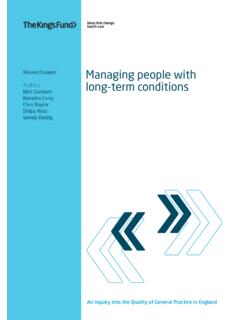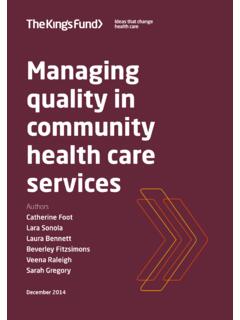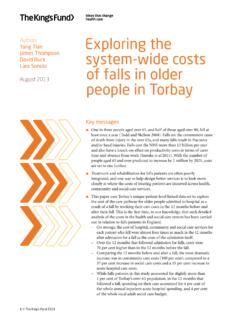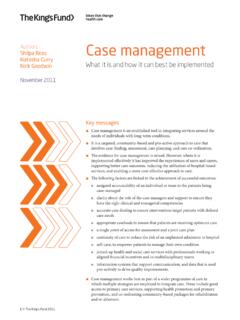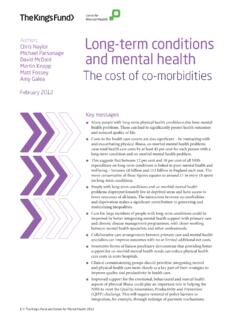Transcription of Home care in England - King's Fund
1 Home care in EnglandViews from commissioners and providers Editor: Simon BotteryAuthors: Laura Jefferson, Laura Bennett, Patrick Hall, Julia Cream, Veronica Dale, Matthew Honeyman, Yvonne Birks, Karen Bloor, Richard MurrayDecember 2018 Home care in England 1 2 3 Contents 1 ContentsBeyond time and task: introduction 2 Findings 7 Staffing remains a fundamental challenge 7 Location is key 11 Councils have held down fees 13 Views differ on whether rates have affected quality 17 Time-and-task commissioning remains the dominant approach 20 Integration with health is patchy 24 Some alternative home care models are not new 30 Recent technological innovations still to prove impact 32 Conclusions 36 References 40 About the editor and acknowledgements 44123 Beyond time and task: introduction 2 Home care in England 1 2 31 Beyond time and task: introductionTraditionally, home care has been commissioned and delivered on a time and task model.
2 This prioritises procedure and amount of time spent on care over meeting the needs of individual people.(National Institute for Health and Care Excellence (NICE) 2015)Home care (also known as domiciliary care) is the front line of social care delivery. In 2015, more than 350,000 older people in England were estimated to use home care services, 257,000 of whom had their care paid for by their local authority. A further 76,300 younger people with learning disabilities, physical disabilities or mental health problems were also estimated to be using publicly funded home care (Wittenberg and Hu 2015).The term home care covers a wide range of activities. The provision of personal care (help with washing, dressing and eating) to people with long-term care needs is the core service provided by most local authorities, but home care also extends to reablement services for people leaving hospital or receiving crisis interventions to avoid hospital attendance in the first place.
3 The term can also include help with household tasks the mopping and shopping activities that many people may need to live independently. However, under the eligibility guidelines applied in England , the requirement for these latter activities alone would not entitle people to local authority help and, in most cases, would need to be paid for privately. Some home care is also provided on a live-in basis. The United Kingdom Homecare Association (UKHCA) estimates that around 249 million hours of home care are delivered in England each year (Holmes 2016). As a service, it is critical to the longstanding strategic intention to enable people to age in place and to deliver care as close as possible to people s homes. It is, or should be, central to the NHS strategic driver of helping frail and older people stay healthy and independent, avoiding hospital stays where possible (NHS England 2017b). It is Beyond time and task: introduction 3 Home care in England 1 2 3also an essential component of care that responds to the priorities of those using it, which can be summarised as.
4 The ability to remain at home in clean, warm, affordable accommodation; to remain socially engaged; to continue with activities that give their life meaning; to contribute to their family or community; to feel safe and to maintain independence, choice, control, personal appearance and dignity; to be free from discrimination; and to feel they are not a burden to their own families and that they can continue their own role as caregivers. (Oliver et al 2014)Commissioning and delivering home care of the highest quality, connected as closely as possible with health and housing services, and with the best outcomes and greatest efficiency, should be a significant objective for our health and social care system. Yet the future of home care is uncertain and the market is fragile. A survey of directors of adult social services in 2017 found that 39 per cent had experienced home care providers ceasing to trade in the previous six months and 37 per cent had experienced contracts handed back (Association of Directors of Adult Social Services 2017).
5 In the past two years, three of the biggest national providers of home care (Saga, Care UK and Housing & Care 21) have withdrawn from the publicly funded home care market, while two others (Mears and Mitie) reported losses in their home care divisions. Mitie subsequently sold its home care business for 2 (BBC News 2017). The market from which they are withdrawing is large and diverse. The Care Quality Commission (CQC), which inspects and regulates home care providers, says there were around 8,500 domiciliary care services in 2016/17. It notes substantial churn , with around 500 agencies registering each quarter and 400 de-registering (Care Quality Commision 2017). More agencies are de-registering before having provided any services which, according to the CQC, adds to uncertainty in the sector and concerns about lack of care continuity. Home care agencies employ around 680,000 people (similar to the numbers employed in residential care), of whom the vast majority do direct care as care workers (Skills for Care 2018).
6 These numbers are likely to need to increase significantly in the coming years to cater for growing need, yet the care sector struggles to recruit even the number of staff it currently needs (there are around Beyond time and task: introduction 4 Home care in England 1 2 3110,000 vacancies at any one time). Over half of home care workers are employed on zero-hours contracts more than in any other sector of social care and turnover is also highest for domiciliary care, with a third of staff leaving their role within the previous year and the turnover of care workers running at over 4 in of care is far from uniform: of the 5,788 agencies inspected by the CQC, 81 per cent were good and 3 per cent outstanding; 16 per cent required improvement and 1 per cent were inadequate. These are similar ratios to residential care homes and most other community social care services. And as with other care services, smaller providers were more likely to be rated as good (85 per cent compared to 73 per cent of services for more than 100 people).
7 Under the Care Act 2014, local authorities have a statutory duty to shape this market to ensure that there are sufficient services of a sufficiently high quality to meet needs. An indication that this is not the case comes from the increasing wait for home care packages for people ready to leave NHS hospitals. This is now the single biggest reason for delayed discharge, rising from 12,777 bed days lost in August 2010 to 33,520 in March 2018 (NHS England 2017a). However, the length of wait varies significantly, highlighting a key theme of this report that the market being shaped differs significantly from area to area. How councils respond to these differing local circumstances is at least in part driven by the state of their budgets. The Local Government Association (LGA) says that, by the end of this decade, English councils will have had a 16 billion reduction in government grant funding since 2010, at a time when there are increasing numbers of ageing and disabled people (Local Government Association 2017).
8 Councils are therefore caught in the crossfire between rising demand and reduced funding. As a consequence, control of expenditure on social care has been vital, and one key factor in this is the rate they pay to private providers for commissioned home care. Since their local situations vary significantly, in practice this means that different councils may pay very different colleague in Gloucestershire pays 26 an hour [to buy home care services], my colleague in Oxfordshire pays 22, I pay and there are colleagues at less than 14. In the main, those are sustainable figures because, in different parts of the country, the labour costs are very Garrod, Association of Directors of Adult Social Services (ADASS), giving oral evidence (House of Commons Public Accounts Committee 2018) Beyond time and task: introduction 5 Home care in England 1 2 3 Others, however, argue that the market is not sustainable and point to the number of provider withdrawals as evidence.
9 This concern may be responsible for a recent year-on-year increase in the rates councils pay for externally commissioned home care up by over 7 per cent from in 2015/16 to in 2016/17 (NHS Digital 2017). It may be that the drive to lower rates has finally bottomed in the face of market realities. This report aims to understand the key trends and challenges facing the home care sector, based on discussions with commissioners, providers and national social care organisations. It draws on work carried out between 2016 and 2018, when The king s Fund produced three linked pieces of research into issues affecting the home care market in England , in collaboration with the University of York. Adult social care: local authority commissioning behaviours, which examined the factors driving commissioning of adult social care (including care homes) in England (Jefferson et al 2017). It explored the factors that either constrain or support commissioners to use their purchasing powers to shape the market.
10 In total, 23 participants from 20 organisations local authorities and national stakeholders were interviewed. Understanding domiciliary care in England , which aimed to improve understanding of the mechanisms of purchasing and delivery of home care, including the current state of supply and demand and key drivers of market dynamics (Hall et al 2017). It drew on the report into local authority commissioning behaviours, but also used the following analysis: a literature review of reports, articles and reviews published in the previous five years national data analysis, drawing on samples of the labour force data supplied by Skills for Care from the National Minimum Data Set for Social Care (NMDS-SC) and data on registered providers of care from the CQC, along with data on expenditure and activity from NHS Digital. Other data sources included the Relative Needs Formula for adult social care, which estimates need to guide local funding; data on delayed transfer of care; and contextual data from the Indices of Deprivation and the Annual Survey of Hours and Earnings 20 qualitative interviews with providers and commissioners in six locations across England , as well as interviews with a number of national stakeholders, including the CQC.



